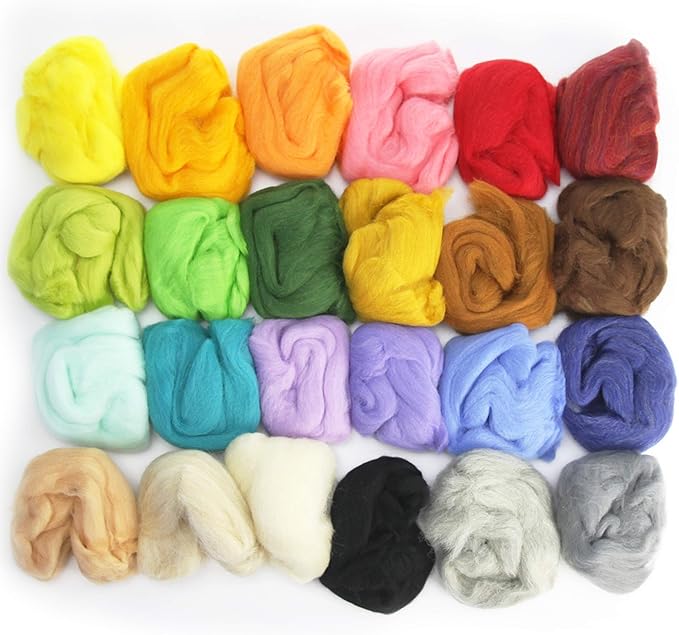Exploring the Rainbow: A Guide to Choosing Wool Roving Colors for Your Projects

Crafting with wool roving opens up endless possibilities for creativity. Whether you're an experienced needle felter, a spinner, or a beginner exploring new crafts, choosing the right wool roving colors can transform your project from ordinary to extraordinary. Color selection plays a vital role in the overall aesthetic of your finished piece, and understanding how to effectively use colors will enhance your crafting experience.
Understanding Wool Roving and Its Color Properties
Wool roving is the soft, fluffy material created during the processing of raw wool. It's cleaned, carded, and sometimes dyed, making it a versatile medium for crafts like needle felting, wet felting, spinning, and weaving. Wool roving's natural ability to blend colors allows crafters to achieve stunning gradients, textures, and effects.
Choosing the Right Wool Type for Your Project
Before diving into color selection, it's important to choose the right type of wool for your specific craft. Wool roving comes from different breeds of sheep, and each has unique properties that affect texture, blending, and dye absorption.
- Merino Wool: Known for its softness, Merino is excellent for detailed projects and fine felting. Its smooth fibers take dye beautifully, offering vibrant wool roving colors.
- Corriedale Wool: Slightly coarser than Merino, Corriedale is a favorite for beginners because it felts quickly and evenly. It's ideal for projects needing texture.
- BFL (Bluefaced Leicester) Wool: With long fibers and a silky texture, BFL wool is fantastic for spinning and creating draped effects in felting.
- Icelandic Wool: This coarse fiber works well for structural felting projects or pieces needing durability.
Selecting the right wool ensures that the colors you choose will complement your project, whether it's a soft felted animal or a sturdy wall hanging.
The Importance of Color Theory in Crafting
Color isn't just decoration—it's a powerful tool for storytelling and emotion. Understanding basic color theory helps you make intentional choices when selecting wool roving colors.
Using the Color Wheel to Guide Your Selections
The color wheel is an essential tool for understanding relationships between colors. Here's how it can help in crafting:
- Primary Colors: Red, blue, and yellow are the foundational hues that create all other colors. Building a palette with these three is a great way to experiment if you're just starting out.
- Secondary Colors: Created by mixing primary colors, these include green, orange, and purple. They're versatile for creating contrast and harmony.
- Tertiary Colors: These nuanced hues are blends of primary and secondary colors, perfect for subtle gradients and shading.
Harmonizing Colors
- Complementary Colors: These are opposite on the color wheel (e.g., red and green). Using them together creates high contrast, making elements in your project stand out.
- Analogous Colors: Found side-by-side on the wheel (e.g., blue, teal, and green), these colors create a cohesive and calming palette.
- Triadic Colors: Forming a triangle on the wheel, triadic schemes (e.g., red, yellow, blue) offer vibrant and balanced combinations.
When selecting wool roving colors, consider the mood of your project. Warm tones like red and orange convey energy, while cool hues like blue and green evoke calmness.
Tips for Mixing and Matching Wool Roving Colors
Color blending is where creativity truly shines. Whether you're mixing shades for felting or creating a gradient for spinning, understanding how to combine wool roving colors effectively is key.
Layering for Visual Depth
One way to create dimension in your projects is by layering colors. For instance, when crafting a needle-felted landscape, use dark green wool as the base for grass, adding lighter shades and small pops of yellow to mimic sunlight. Layering creates depth and richness, making your projects more dynamic.
Experimenting with Ombre and Gradient Effects
To achieve seamless transitions between colors, gently pull apart and overlap two shades of roving. Hand-blend the fibers until you achieve the desired gradient. This technique is perfect for felting or spinning yarn with a smooth color flow.
Dyeing Your Own Wool Roving for Custom Colors
Dyeing your own wool roving is an exciting option for those who want complete control over their palette. It allows you to create unique shades that perfectly match your vision.
Preparing for the Dyeing Process
To dye wool roving, you'll need acid dyes (or natural alternatives), vinegar, and a heat source like a microwave or stovetop. Before starting, ensure your wool is clean and free of lanolin, as this can affect dye absorption.
Techniques for Achieving Vibrant or Subtle Results
- Solid Dyeing: Submerge the wool in a single color bath for uniform results.
- Speckle Dyeing: Sprinkle dye powders over wet wool to create a speckled, variegated effect.
- Dip Dyeing: Gradually lower the wool into the dye bath to create an ombre effect.
- Hand-Painting: Use brushes or squeeze bottles to paint custom designs directly onto the wool.
Dyeing your wool gives you the freedom to experiment with color combinations that aren't commercially available.
Encouraging Creative Exploration with Woolbuddy
At the heart of every craft is the freedom to explore and experiment. Wool roving colors are a playground for your creativity, allowing you to bring your visions to life. Don't hesitate to mix, layer, or dye until you find the perfect combination for your project.
Whether you're a seasoned crafter or a curious beginner, Woolbuddy is here to support your journey. As a family-run business in the U.S., Woolbuddy offers a wide variety of premium needle felting supplies, kits, wool roving, mats, and adorable felted animals. Our customer-centric approach ensures you have everything you need to succeed in your craft.
Ready to get started? Explore our collection of high-quality wool roving colors and crafting supplies. Let your imagination take the lead and create something truly extraordinary.









